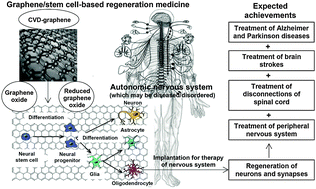Graphene scaffolds in progressive nanotechnology/stem cell-based tissue engineering of the nervous system
Abstract
Although graphene/stem cell-based tissue engineering has recently emerged and has promisingly and progressively been utilized for developing one of the most effective regenerative nanomedicines, it suffers from low differentiation efficiency, low hybridization after transplantation and lack of appropriate scaffolds required in implantations without any degrading in functionality of the cells. In fact, recent studies have demonstrated that the unique properties of graphene can successfully resolve all of these challenges. Among various stem cells, neural stem cells (NSCs) and their neural differentiation on graphene have attracted a lot of interest, because graphene-based neuronal tissue engineering can promisingly realize the regenerative therapy of various incurable neurological diseases/disorders and the fabrication of neuronal networks. Hence, in this review, we further focused on the potential bioapplications of graphene-based nanomaterials for the proliferation and differentiation of NSCs. Then, various stimulation techniques (including electrical, pulsed laser, flash photo, near infrared (NIR), chemical and morphological stimuli) which have recently been implemented in graphene-based stem cell differentiations were reviewed. The possibility of degradation of graphene scaffolds (NIR-assisted photodegradation of three-dimensional graphene nanomesh scaffolds) was also discussed based on the latest achievements. The biocompatibility of graphene scaffolds and their probable toxicities (especially after the disintegration of graphene scaffolds and distribution of its platelets in the body), which is still an important challenge, were reviewed and discussed. Finally, the initial recent efforts for fabrication of neuronal networks on graphene materials were presented. Since there has been no in vivo application of graphene in neuronal regenerative medicine, we hope that this review can excite further and concentrated investigations on in vivo (and even in vitro) neural proliferation, stimulation and differentiation of stem cells on biocompatible graphene scaffolds having the potential of degradability for the generation of implantable neuronal networks.

- This article is part of the themed collection: 2016 Journal of Materials Chemistry B Most Accessed Manuscripts

 Please wait while we load your content...
Please wait while we load your content...